There is more than corn in Indiana! The state is home to one hundred thousand acres of publicly owned lakes and forty-five miles of Great Lakes shoreline. From lakes with amusement parks to smaller quaint bodies of water and communities, Indiana has plenty of options. One of the state’s lakes is even a sci-fi front for secret operations, or so they say!
Indiana’s lakes present many different options for swimming and beachgoers. Anglers aren’t disappointed with the state’s offerings either. An very wide range of fish species swim the water of the state’s lakes from steelhead to crappie to largemouth and native hybrid bass. Hunting is extremely popular at the lakes as well; bow and rifle hunting for deer is common at many Indiana lakefronts and surrounding areas.
Lastly, it would be a shame to mention Indiana and lakes without covering Indiana Beach Amusement Park. Visitors can find over thirty rides, a water park, a miniature golf course, and of course, roller coasters. Whatever lake experience is for you is ready and waiting in the great state of Indiana.
Let’s dive into the best lakes in Indiana!
1. Monroe Lake
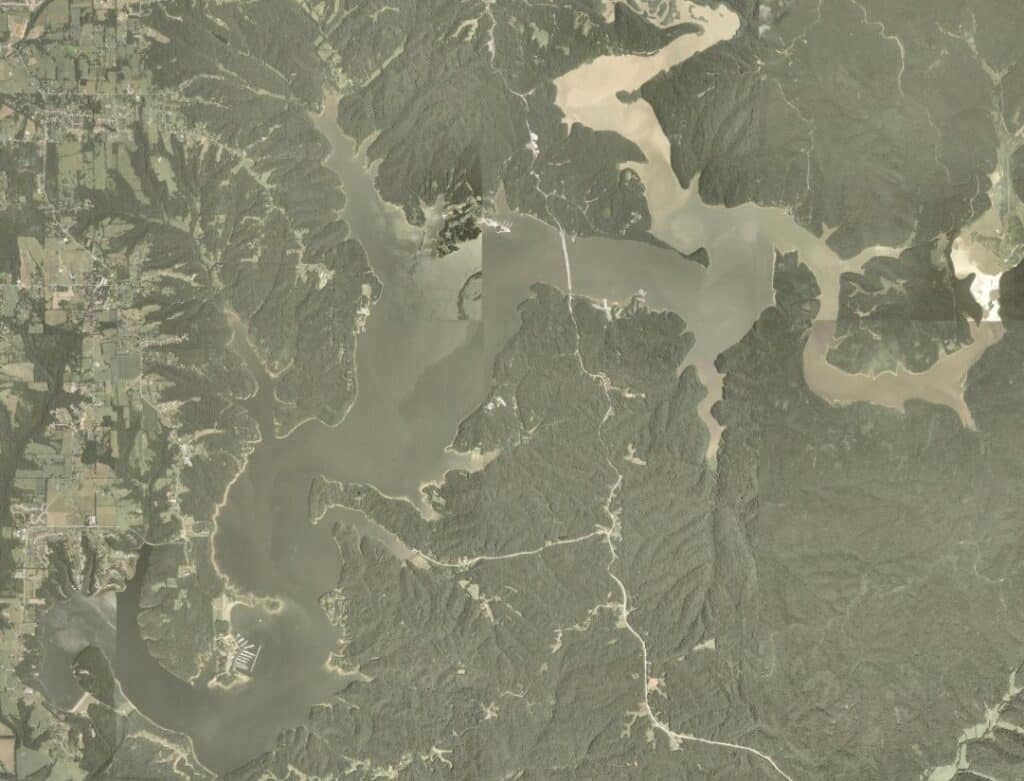
Popular in sci-fi, awesome for anglers, full service for families, Lake Monroe literally has it all!
©NASA / public domain – License
● Surface Area: 10,750 acres
● Max Depth: 54 Feet
● Camping/Overnight Available: Yes
● Boating/Docks Available: Yes
● Swimming Permitted: Yes
● Fishing Permitted: Yes
● Best For: Lunker Bass & Big Catfish, Tournament Crappie Fishing, SCP Foundation Site-81
Lake Monroe is the largest man-made reservoir in the state of Indiana. The south end of the lake is home to Charles C. Deam Wilderness Area, the only federally protected U.S. Wilderness Area in the state. Visitors can enjoy the full-service amenities available at the lake including a hotel resort, restaurants, marina, and a beach for swimmers.
The lake was once known as the “Dead Sea” for the complete and total lack of fish. Conditions have improved dramatically enabling anglers to take full advantage of the killer fishing at Lake Monroe. Some of the hot species at the lake include largemouth bass, channel catfish, and crappie; the waters are also home to the federally endangered clubshell mussel and Indiana bat. Lake Monroe sports nine boat ramps and just over one hundred miles of amazing coastline.
Hunting is allowed in all non-developed areas surrounding the lake. Nearby Hoosier National Forest is another popular destination for hikers, birdwatchers, and wildlife enthusiasts. In popular sci-fi culture, the fictional SCP Foundation’s Site 81 is said to be beneath Monroe Lake.
2. Patoka Lake
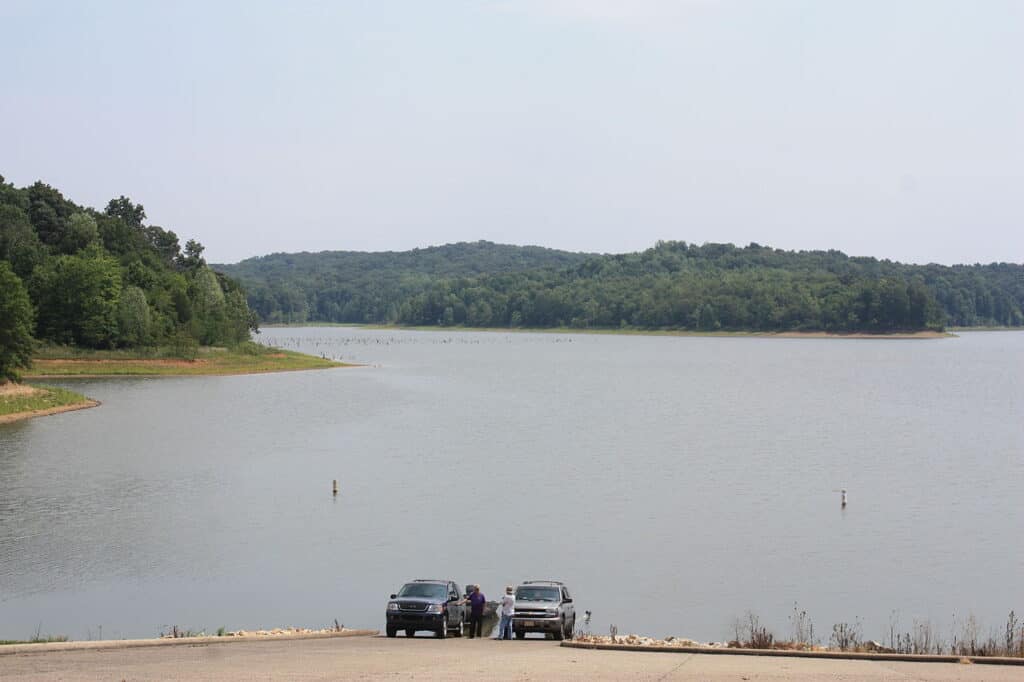
Anglers head out for Patoka Lake to catch trophy-sized crappie while the rest of the family relaxes on the twelve hundred foot-long swimming beach
©Sarah Ewart / Creative Commons – License
● Surface Area: 8,800 acres
● Max Depth: 52 Feet
● Camping/Overnight Available: Yes
● Boating/Docks Available: Yes
● Swimming Permitted: Yes
● Fishing Permitted: Yes
● Best For: Indiana’s Best Crappie & Bass Lake, Hosted 2008 Crappie USA National Classic, “Jewel of Southern Indiana”
Patoka Lake was formed by blocking the Patoka River with one hundred and forty-five foot Patoka Lake Dam. The lake is situated in the south-central part of Indiana and is the state’s second-largest reservoir. In addition to fishing, camping, and boating other popular activities at Patoka Lake include water skiing, wakeboarding, hiking, biking, horseback riding, wildlife viewing, cross-country skiing, downhill skiing, snowboarding, casinos, and ice-fishing.
Visitors to Patoka Lake can utilize the seven state recreation areas available and relax on the twelve hundred foot-long swimming beach. There are seventeen miles of paved bike trails, an archery range, a disc golf course, and hunting. Some of the game hunted at Patoka Lake include deer, rabbit, squirrel, turkey, quail, dove, and migratory game birds.
Crappie fishing is out of this world at the lake; both white and black species. Other fish found swimming in Lake Patoka include largemouth bass, channel catfish, walleye, bluegill, redear sunfish, white bass, wipers, and striped bass.
Patoka Lake is located within the Hoosier National Forest. The forest provides habitat for fifty species of mammals, nearly one hundred and fifty types of birds, thirty-six reptilian species, twenty-eight amphibian species, and over one hundred species of fish in total.
3. Geist Reservoir

Geist Reservoir is the second-largest man-made lake in Indiana and known for tournament-level bass fishing
● Surface Area: 1,900 acres
● Max Depth: 48 Feet
● Camping/Overnight Available: Yes
● Boating/Docks Available: Yes
● Swimming Permitted: No
● Fishing Permitted: Yes
● Best For: Source of Water For Indianapolis, Bass Tournaments, Second Largest Man-Made Lake In Indiana
Geist Reservoir is a thirty-minute drive from Indianapolis providing outdoor recreation within a large city environment. It’s the second-largest man-made lake in Indiana and known for outstanding bass fishing.
Anglers heading to Geist Reservoir can expect to hook largemouth bass, channel catfish, and bluegill. Other fish species recorded at the lake include flathead catfish, black crappie, walleye, bluegill, redear sunfish, and striped bass. Geist Reservoir is noted for tournament-level bass fishing.
Recently a secondary containment was built in conjunction with Geist Reservoir. The Citizens Reservoir is an eighty-eight-acre body of water constructed to help and serve future generations’ needs. Conservation of Geist Reservoir, the surrounding area, and overall treatment and conditions of the lake have become of paramount importance in modern times.
4. Lake Maxinkuckee
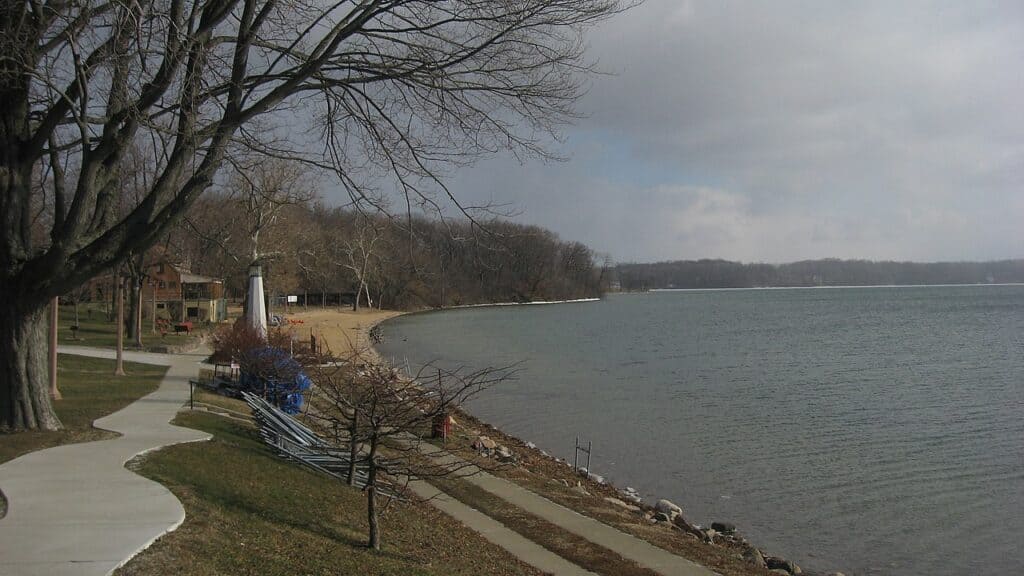
Lake Maxinkuckee is the second largest natural lake in the state of Indiana and is known for outstanding walleye fishing
● Surface Area: 1,864 acres
● Max Depth: 88 Feet
● Camping/Overnight Available: Nearby Hotels
● Boating/Docks Available: Yes
● Swimming Permitted: Yes
● Fishing Permitted: Yes
● Best For: Walleye Fishing, Second Largest Natural Lake In Indiana, Family Friendly, Culver Beach, Quaint
Lake Maxinkuckee is a glacially formed kettle lake found in the northwest corner of Indiana near the town of Culver. Tourists to the area and locals swam to Culver Beach in the warmer months. Culver Beach is part of Culver Park, a five-acre area that includes shops, restaurants, and many other amenities and family-friendly activities.
Visitors wishing to stay for more than a day trip to Lake Maxinkuckee can check into the cabins, cottages, and other vacation rentals around the lake’s ten-mile shoreline. With the lake’s rise in popularity, the Lake Maxinkuckee Environmental Council has been assigned to ensure the water and surrounding areas are kept immaculately clean.
Lake Maxinkuckee’s depth brings out scuba divers regularly. Anglers know the lake for its extremely abundant walleye. Other species pulled from the lake include large and smallmouth bass, crappie, white bass, black bass, rock bass, walleye, trout, sunfish, bluegill, and yellow perch. Boats can be launched at several ramps at the lake and pier fishing is also available in a family-friendly environment.
5. Lake Lemon
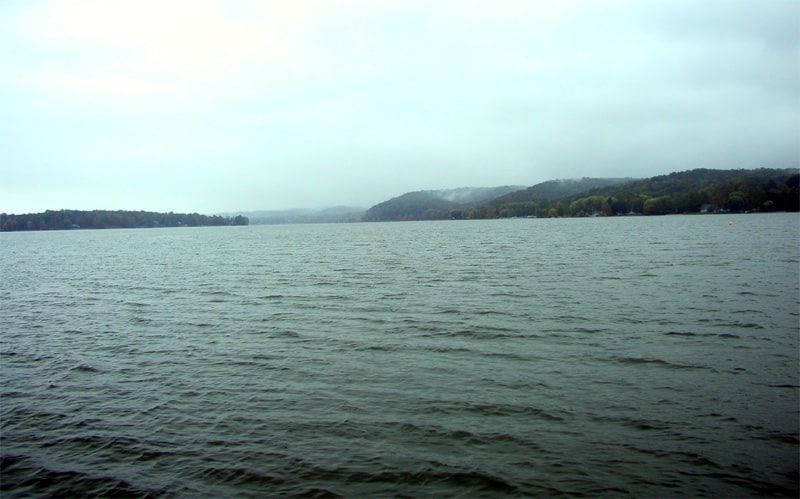
Lake Lemon is a tranquil, less inundated lake offering all the same amenities and killer fishing opportunities; there’s even boat racing!
● Surface Area: 1,650 acres
● Max Depth: 20 Feet
● Camping/Overnight Available: No
● Boating/Docks Available: Yes
● Swimming Permitted: Yes
● Fishing Permitted: Yes
● Best For: Boat Races, Tranquil Environment, ADA accessible, Eleventh Largest Lake In Indiana, Riddle Point Park Beach
Lake Lemon is located in Unionville, Indiana, ten miles northeast of Bloomington. It’s the eleventh largest lake in the state providing a laid-back, tranquil environment in contrast to some of the state’s other larger lakes. The lake’s water once served as Bloomington’s primary source, being replaced later by Lake Monroe.
Anglers can throw a line in along the twenty-five miles of shoreline or utilize the boat ramps available. Lake Lemon’s more abundant fish species include largemouth bass, bluegill, crappie, channel, and flathead catfish. Boat racing is another popular attraction at Lake Lemon so be sure to check ahead for race schedules and other related information.
While the fishing enthusiasts are reeling in their next fish story the family can relax and swim at the amazing beach at Riddle Point Park. Wildlife enthusiasts and birdwatchers can spot many different animals and birds including beaver, muskrat, bald eagle, heron, and egret.
6. Lake Freeman
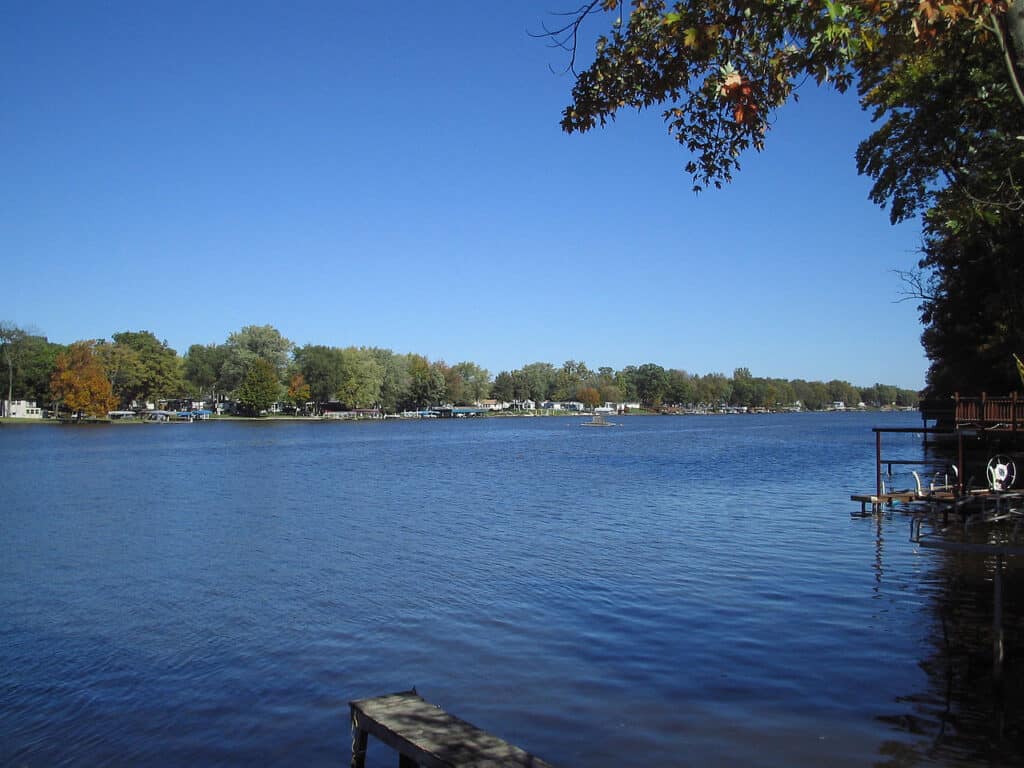
Visitors to Lake Freeman can enjoy a relaxed day of fishing or a ride on the Madam Carroll pleasure excursion vessel
● Surface Area: 1,500 acres
● Max Depth: 45 Feet
● Camping/Overnight Available: Yes
● Boating/Docks Available: Yes
● Swimming Permitted: Yes
● Fishing Permitted: Yes
● Best For: Walleye Fishing, Relaxed & Less Busy Lake Experience, Madam Carroll Excursion Vessel Rides, Part of Twin Lakes Region
Lake Freeman and Lake Shafer are part of what’s known as the Twin Lakes region in northeastern Indiana. Lake visitors can enjoy a ride on the Madam Carroll pleasure excursion vessel for a unique experience. Lake Freeman is more relaxed there are fewer people and less noise in contrast to its sister lake.
Anglers in the know head for Lake Freeman in hopes of catching their limit of huge walleye. If those aren’t biting plenty of other fish species populate the lake including largemouth bass, smallmouth bass, striped bass, white bass, catfish, crappie, bluegill, and muskie. For lake goers who aren’t interested in fishing the lake also provides a swimming beach at Bluewater Park.
In addition to the usual fishing, boating, and camping, Lake Freeman also plays an important role in providing habitat to a range of wildlife. Many types of animals and birds call the less developed lake and surrounding area home. Some of the different wildlife that can be seen around Lake Freeman include white pelican, swans, bald eagles, cranes, loons, ducks, pileated woodpecker, hawks, heron, raccoons, and deer.
7. Lake Shafer
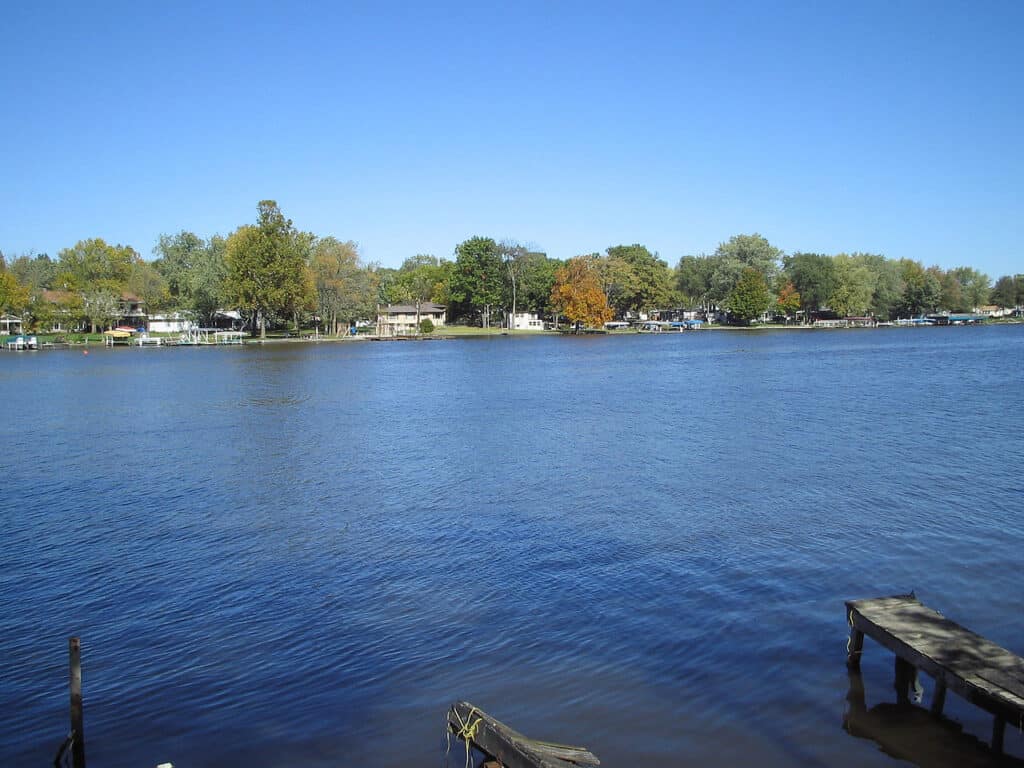
Lake Shafer is the second half of the Twin Lakes region of the Monticello area of Indiana and home to the infamous Indiana Beach amusement park
● Surface Area: 1,289 acres
● Max Depth: 30 Feet
● Camping/Overnight Available: Yes
● Boating/Docks Available: Yes
● Swimming Permitted: Yes
● Fishing Permitted: Yes
● Best For: Indiana Beach Amusement Park, Bass Anglers Fishing Tournament Host
Long-time locals might remember the TV commercial with the saying “There is more than corn in Indiana!” It was an advertisement for one of the area’s largest and most well-known attractions, Indiana Beach Amusement Park. The park provides over thirty rides, a water park, a miniature golf course, and of course, roller coasters.
Lake Shafer’s fifty miles of shoreline are owned and maintained by the Northern Indiana Public Service Company. The Twin Lakes area provides over one hundred camps, resorts, and various hotspots for tourists. Lake Shafer has a constant supply of freshwater pumped in from the Tippecanoe River.
While the family is enjoying the barrage of amenities and activities provided by the lake, anglers can spend the day finding their next catch. Fish species that inhabit the lake include smallmouth bass, largemouth bass, hybrid striped bass, walleye, channel catfish, white bass, bluegill, carp, and white crappie. The fishing action doesn’t stop there, Lake Shefer is also the host of the Bass Anglers Fishing Tournaments.
8. Lake James

Lake James is a glacially formed lake with a rich history of cottage owners and trains, today it’s utilized by locals and tourists looking for water recreation, fishing, camping and swimming for the whole family
©Chris Light / Creative Commons – License
● Surface Area: 1,228 acres
● Max Depth: 88 Feet
● Camping/Overnight Available: Yes
● Boating/Docks Available: Yes
● Swimming Permitted: Yes
● Fishing Permitted: Yes
● Best For: Boating, Camping & Water Skiing, Ranked Top Indiana Lake, Extremely Clean
Lake James is a glacially created body of water located in the upper northeast corner of Indiana. In the humble beginnings of the community, it was very difficult to reach the lake, and cottage owners would ride a train then boat just to reach their homes! Today the lake is utilized for fishing, boating, camping, hiking, beaches, swimming, water skiing, and many other outdoor recreational activities.
The lake and surrounding area have been recognized as one of the cleanest in Indiana. Lake James is located within Pokagon State Park and the nearby town of Angola. Summer and winter fishing are both very popular at Lake James. Fish species that inhabit the waters include yellow perch, largemouth bass, northern pike, bluegill, rock bass, and spotted gar.
Birdwatching and wildlife viewing at the park and lake are highly productive. Just a few of the animals and birds that roam the area include nesting cerulean warblers, veeries, pine warblers, sandhill cranes, osprey, hooded mergansers, great blue heron, red-winged blackbird, Baltimore oriole, pileated woodpecker, owls, turkeys, ducks, geese, gulls, purple martins, bald eagles, brown creepers, bluebirds, Carolina wrens, garter snake, eastern massasauga, hognose snake, the northern water snake, painted turtles, snapping turtles, shell turtles, loons, grebes, and double-crested cormorants, hawks, red-headed woodpeckers, barred owls, great horned owls, beavers, coyotes, and foxes.
Largest Natural Lake In Indiana
What’s the largest natural lake contained entirely within Indiana? Let’s take a look at Lake Wawasee, which covers more than 3,000 acres.
9. Lake Wawasee
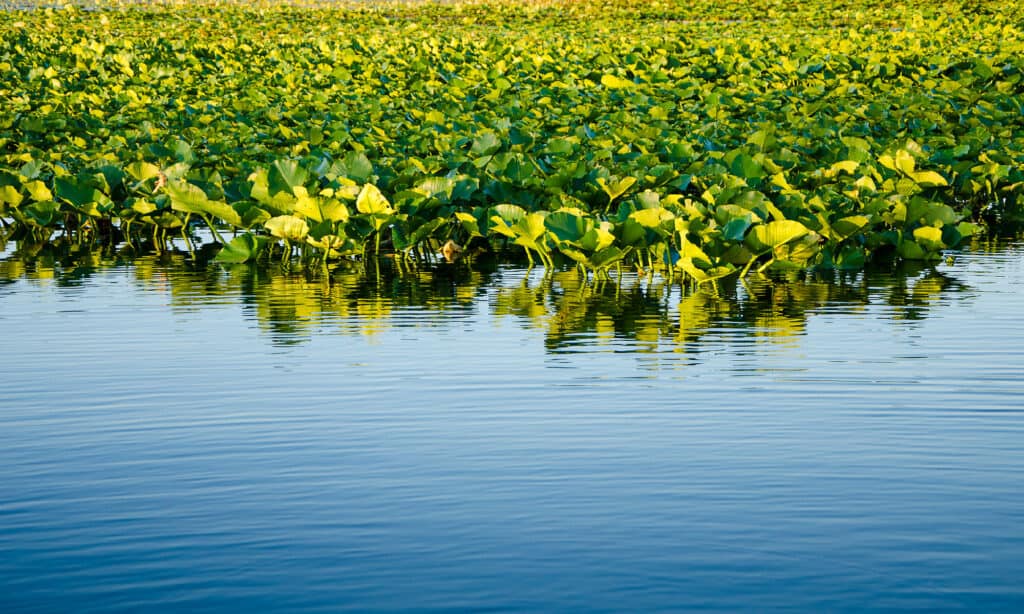
Lake Wawasee is the largest natural lake in the state of Indiana, presenting glistening blue-green water, ADA-accessibility, and tons of other outdoor recreational amenities and activities
©iStock.com/AdrianHdzBz
● Surface Area: 3,059 acres
● Max Depth: 72 Feet
● Camping/Overnight Available: Yes
● Boating/Docks Available: Yes
● Swimming Permitted: Yes
● Fishing Permitted: Yes
● Best For: Largest Natural Lake In Indiana, Annual Fireworks, Bass Fishing Tournaments, ADA-accessible
Lake Wawasee is the largest natural lake entirely in the state of Indiana. The lake bed was carved by glacial activity millions of years ago. At one time the glistening blue-green lake was known as Turkey Lake; later renamed after a native American chief.
The area around Lake Wawasee is Amish country and nestled up against the quaint community town of Syracuse. Visitors can enjoy any of the amenities available in Syracuse including a planetarium, museums, antique shops, and fine dining. The lake itself boasts ADA-accessible features for disabled guests providing them with camping and fishing opportunities.
Conditions at Lake Wawasee are managed by the Wawasee Area Conservancy Foundation which provides a strong restoration and preservation program. Anglers can try their luck fishing for some of the twenty-eight species of fish in the lake including bluegill, largemouth bass, black bass, northern pike, yellow perch, shellcracker, and black crappie. Lake Wawasee also hosts bass fishing tournaments!
Largest Lake In Indiana
All other lakes in Indiana are overshadowed by one massive lake that sits in its northwest corner. Lake Michigan is Indiana’s largest lake and has a number of activities along its shoreline!
10. Lake Michigan

Lake Michigan is a massive body of water with over forty miles of shoreline in the state of Indiana
©iStock.com/Focqus, LLC
● Surface Area: 14,272,000 acres
● Max Depth: 922 Feet
● Camping/Overnight Available: Yes
● Boating/Docks Available: Yes
● Swimming Permitted: Yes
● Fishing Permitted: Yes
● Best For: Only Great Lake Only In USA, Largest Body of Water In Any Single Country, The Lake Michigan Bermuda Triangle Tales, Great Steelhead & Salmon Fishing
Lake Michigan is the only Great Lake entirely contained within the USA and it’s the largest body of water in any single country! On top of that, the lake is home to the world’s largest collection of freshwater sand dunes. The lake even has its own Bermuda Triangle legends and stories.
Indiana holds just forty-three miles of the lake’s massive shoreline but it’s enough for hungry anglers looking to hook a huge steelhead or native Lake Michigan lake trout. Other species of fish swimming in the waters include coho salmon, perch, chinook salmon, rainbow trout, lake trout, brown trout, smallmouth bass, largemouth bass, and walleye.
The region has been called the “Third Coast” of the United States because of the size and magnitude of water, beaches, and amenities. Birdwatching is quite popular around the lake with opportunities to view common loons, horned grebe, double-crested cormorant, great blue heron, least bittern, American black duck, blue-winged teal, sharp-shinned hawk, American kestrel, northern bobwhite, dunlin, pectoral sandpiper and many types of ducks.
The photo featured at the top of this post is © iStock.com/Focqus, LLC
Thank you for reading! Have some feedback for us? Contact the AZ Animals editorial team.






